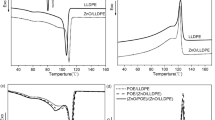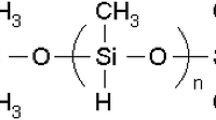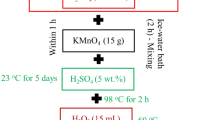Abstract
Nanometer Zinc oxide (nano ZnO) composites are widely used in the packaging industry due to their excellent antibacterial properties. In this study, low-doped (0.2%) and high-antibacterial (99.9%, R = 6.9) nano ZnO composites with different matrices were prepared using a masterbatch blending method. To investigate the effect of different matrices on antibacterial properties, we decreased the solid content of nano ZnO to 0.05% and prepared antibacterial films by melt-blending with ethylene vinyl acetate copolymer (EVA), polyolefin elastomer (POE), linear low-density polyethylene (LLDPE), high-density polyethylene (HDPE), and amorphous polymer polycarbonate (PC). The results showed that low melt strength and high crystallinity would decrease the antibacterial activity of the composite. At room temperature, the PC with a frozen molecular chain can hinder the migration of small molecules, thereby reducing antibacterial activity. Polar ZnO is more compatible with polar vinyl acetate (VA), leading to the hindered surface migration of ZnO and reduced antibacterial activity. Most importantly, low crystallinity does not necessarily lead to a reduction in barrier properties. The dense and rich layered arrangement of polyolefin elastomer (POE) increases its ability to impede the migration of nano ZnO, thereby significantly reducing its antibacterial effectiveness. A concentration of 0.05% ZnO/linear low-density polyethylene (LLDPE) exhibited an antibacterial rate of up to 99.3%. Additionally, adding a small amount of nano ZnO improves the tear resistance of antibacterial composite materials. This study provides a theoretical basis for the preparation of low doping, high antibacterial and excellent comprehensive performance.







Similar content being viewed by others
Data availability
The data that support the findings of this study are available on request from the corresponding author.
References
Abdali H, Ajji A (2015) Development of antibacterial structures and films using clove bud powder. Ind Crop Prod 72:214–219. https://doi.org/10.1016/j.indcrop.2014.09.050
Dobrucka R, Ankiel M (2018) Possible applications of metal nanoparticles in antimicrobial food packaging. J Food Safety 39:e12617. https://doi.org/10.1111/jfs.12617
Augustine R, Malik HN, Singhal DK, Mukherjee A, Malakar D, Kalarikkal N, Thomas S (2014) Electrospun polycaprolactone/ZnO nanocomposite membranes as biomaterials with antibacterial and cell adhesion properties. J Polym Res 21:347. https://doi.org/10.1007/s10965-013-0347-6
Laijun L, Yu Z, Chaojing L, Jiacheng C, Lu W (2020) Facile preparation PCL/modified nano ZnO organic-inorganic composite and its application in antibacterial materials. J Polym Res 27:28. https://doi.org/10.1007/s10965-020-02046-z
Shadpour M, Vajiheh B (2016) Nanocomposites based on biosafe nano ZnO and different polymeric matrixes for antibacterial, optical, thermal and mechanical applications. Eur Polym J 84:377–403. https://doi.org/10.1016/j.eurpolymj.2016.09.028
Roberto P, Giuliana G, Giovanni V, Marius M, Philippe D (2013) PLA-ZnO nanocomposite films: Water vapor barrier properties and specific end-use characteristics. Eur Polym J 49:3471–3482. https://doi.org/10.1016/j.eurpolymj.2013.08.005
Manaf O, Leya RR, Prasanth R, Mohamed AMN, Sujith A (2021) Maleic anhydride grafted acrylonitrile butadiene styrene (ABS)/zinc oxide nanocomposite: an anti-microbial material. J Polym Res 28:284. https://doi.org/10.1007/s10965-021-02632-9
Daniele V, Loredana T, Fulvia V, Antonella, Ivana C, Gaetana P, Giovanni V (2020) Antibacterial Al-doped ZnO coatings on PLA films. J Mater Sci 55:4830–4847. https://doi.org/10.1007/s10853-019-04311-z
Gorkem G, Aysun A, Birol E, Ufuk P (2018) Production of metal oxide containing antibacterial coated textile material and investigation of the mechanism of action. Fiber Polym 19:2548–2563. https://doi.org/10.1007/s12221-018-8306-9
Atanu N, Sohee L, Kwang-sun K (2020) Antibacterial potential of Ni-doped zinc oxide nanostructure: comparatively more effective against Gram-negative bacteria including multi-drug resistant strains. RSC Adv 10:1232–1242. https://doi.org/10.1039/C9RA09512H
Ge M, Xiaoxi L, Liangchao L, Ru, Donghua J, Yan D, Haifeng C (2014) Cu-doped zinc oxide and its polythiophene composites: Preparation and antibacterial properties. Chemosphere 100:146–151. https://doi.org/10.1016/j.chemosphere.2013.11.053
Yang L, Wen Z, Junfeng Ni, Yongsheng C (2012) Mechanism of photogenerated reactive oxygen species and correlation with the antibacterial properties of engineered metal-oxide nanoparticles. ACS Nano 6:5164–5173. https://doi.org/10.1021/nn300934k
Nagarajan P, Rajagopalan V (2008) Enhanced bioactivity of ZnO nanoparticles-an antimicrobial study. Sci Technol Adv Mat 9:035004. https://doi.org/10.1088/1468-6996/9/3/035004
Leigang M, Biming S, Nawrat S, Chaomin M, Kezhen Q (2017) Facile synthesis of hierarchical ZnO microstructures with enhanced photocatalytic activity. Mater Sci-poland 35:45–49
Buzuayehu A, Enyew Amare Z, Aschalew T (2020) A review on enhancing the antibacterial activity of ZnO: mechanisms and microscopic investigation. Nanoscale Res Lett 15:190. https://doi.org/10.1186/s11671-020-03418-6
Rajesh K, Ahmad U, Girish K, Hari SN (2017) Antimicrobial properties of ZnO nanomaterials: a review. Ceram Int 43:3940–3961. https://doi.org/10.1016/j.ceramint.2016.12.062
Lingling Z, Yunhong J, Yulong D, Malcolm P, David Y (2007) Investigation into the antibacterial behaviour of suspensions of ZnO nanoparticles (ZnO nanofluids). J Nanopart Res 9:479–489. https://doi.org/10.1007/s11051-006-9150-1
Tamar G, Benny P, Ofir H, Israel F, Ehud B, Shlomo M (2011) Synthesis and characterization of zinc/iron oxide composite nanoparticles and their antibacterial properties. Colloid Surf A 374:1–8. https://doi.org/10.1016/j.colsurfa.2010.10.015
Olesja B, Katre J, Angela I, Kaja K, Monika M, Anne K (2013) Toxicity of Ag, CuO and ZnO nanoparticles to selected environmentally relevant test organisms and mammalian cells in vitro: a critical review. Arch Toxicol 87:1181–1200. https://doi.org/10.1007/s00204-013-1079-4
Abdel-Halim ES, Al-Deyab SS (2014) Antimicrobial activity of silver/starch/polyacrylamide nanocomposite. Int J Biol Macromol 68:33–38. https://doi.org/10.1016/j.ijbiomac.2014.04.025
Sharma RK, Balani K (2014) Mechanics of ZnO micro-rod and ZnO nanoparticle reinforcement in ultra-high molecular weight polyethylene biocomposite. J Phys D Appl Phys 47:345301. http://iopscience.iop.org/0022-3727/47/34/345301
Li SC, Li YN (2010) Mechanical and antibacterial properties of modified nano-ZnO/high-density polyethylene composite films with a low doped content of nano-ZnO. J Appl Polym Sci 116:2965–2969. https://doi.org/10.1002/app.31802
Negi H, Agarwal T, Goel ZR (2012) Comparative antibacterial efficacy of metal oxide nanoparticles against Gram negative bacteria. Ann Microbiol 62:765–772
Guinault A, Sollogoub C, Domenek S, Grandmontagne A, Ducruet V (2010) Influence of crystallinity on gas barrier and mechanical properties of PLA food packaging films. Int J Mater Form 3:603–606. https://doi.org/10.1007/s12289-010-0842-9
Rubino M, Netramai S (2010) Effect of Chlorine Dioxide Gas on Physical, Thermal, Mechanical, and Barrier Properties of polymeric packaging materials. J Appl Polym Sci 115:1742–1750. https://doi.org/10.1002/app.31244
Chowdhury SR, Sabharwal S (2011) Molecular-scale design of a high performance organic-inorganic hybrid with the help of gamma radiation. J Mater Chem 21:6999–7006. https://doi.org/10.1039/C1JM10943J
Hong-Biao C, Chang-Ying H (2018) Influence of PP types on migration of zinc from nano-ZnO/PP composite films. Packag Technol Sci 31:747–753. https://doi.org/10.1002/pts.2411
Alojz Anžlovar A, Primožič M, Švab I, Leitgeb M, Knez Ž, Žagar E (2019) Polyolefin/ZnO composites prepared by Melt Processing. Molecules 24:2432. https://doi.org/10.3390/molecules24132432
Guillaume D, Ibon A, Lorena G, Evgeni I, Ekaterina D, Rumania K, Marc V, Jeannette D (2014) Thermal and rheological characterization of antibacterial nanocomposites: poly(amide) 6 and low-density poly(ethylene) filled with zinc oxide. J Thermoplast Compos 27:268–284. https://doi.org/10.1177/0892705712445037
Chengcheng T, Yang L, Ying W, Xinlu H, Li-Zhi L (2023) Effect of polyethylene internal structure on antibacterial properties of nano silver composites. J APPL POLYM SCI 140:e53706. https://doi.org/10.1002/app.53706
Shujun W, Changjiang W, Min-Qiao R, Ryan MV, Matthew J, Erqiang CCH, Stephen C (2009) Liquid-liquid phase separation in a polyethylene blend monitored by crystallization kinetics and crystal-decorated phase morphologies. Polymer 50:1025–1033. https://doi.org/10.1016/j.polymer.2008.12.028
Xinlu H, Ying S, Li-Zhi L, Yi R, Yuanxia W (2021) Crystallization, structure, morphology, and properties of linear low-density polyethylene blends made with different comonomers. POLYM ENG SCI 61:2406–2415. https://doi.org/10.1002/pen.25766
Mylonas E, Svergun DI (2007) Accuracy of molecular mass determination of proteins in solution by small-angle X-ray scattering. J Appl Crystallogr 40:s245–s249. https://doi.org/10.1107/S002188980700252X
Mohand C, Françoise E, Isabelle M, Françoise B, Maria-Rosa A, María-Luisa LD, Julio SR, Nimet B, Erhan P, Omar Z, Roger C (2010) SAXS Investigation of the Effect of temperature on the Multiscale structure of a Macroporous Poly(N-isopropylacrylamide) gel. Macromolecules 43:2009–2017. https://doi.org/10.1021/ma902655h
Sedlak SM, Bruetzel LK, Lipfert J (2017) Quantitative evaluation of statistical errors in small angle X-ray scattering measurements. J APPL CRYSTALLOGR 50:621–630. https://doi.org/10.1107/S1600576717003077
Jellinek MH, Soloman E, Fankuchen I (1946) Measurement and analysis of small-angle X-ray scattering. Ind Eng Chem Anal Ed 18:172–175. https://doi.org/10.1021/i560151a005
Shu-Gui Y, Zhen-Zhen W, Liliana C, Pantea K, Xiang-bing Z, Hui-Jie X, Hina S, Goran U (2021) Bowls, vases and goblets-the microcrockery of polymer and nanocomposite morphology revealed by two-photon optical tomography. Nat Commun 12:5054. https://doi.org/10.1038/s41467-021-25297-w
Shi Y, Zheng C, Minqiao R, Yujing T, Li-Zhi L, Bob H (2017) Evaluation of principal residual stress and its relationship with crystal orientation and mechanical properties of polypropylene films. Polymer 123:137–143. https://doi.org/10.1016/j.polymer.2017.07.006
Enikő F (1993) Transport of small molecules in polyolefins. II. Diffusion and solubility of irganox 1076 in ethylene polymers. J Appl Polym Sci 48:1905–1913. https://doi.org/10.1002/app.1993.070481104
Jeevananda T, Siddaramaiah (2001) Thermal and morphological studies on ethylene-vinyl acetate copolymer–polyaniline blends. THERMOCHIM ACTA 376:51–61. https://doi.org/10.1016/S0040-6031(01)00530-5
Pavlicevic J, Spirkova M, Bera O, Jovicic M, Pilic B, Balos S, Budinski-Simendic J (2014) The influence of ZnO nanoparticles on thermal and mechanical behavior of polycarbonate-based polyurethane composites. COMPOS PART B-ENG 60:673–679. https://doi.org/10.1016/j.compositesb.2014.01.016
Shoichiro Y, Kimio K, Keisuke I, Takeshi F, Mitsuo K (2003) Structure and properties of poly(vinyl alcohol)/tungsten trioxide hybrids. Polymer 44:3515–3522. https://doi.org/10.1016/S0032-3861(03)00281-7
Li-Zhi L, Benjamin C, Benjamin C, Penning, JP, St. JR (1997) A Synchrotron SAXS Study of Miscible Blends of Semicrystalline Poly (vinylidene fluoride) and Semicrystalline Poly (1,4-butylene adipate). Macromolecules 30:4398–4404. https://doi.org/10.1021/ma961719n
Li Y, Wu XJ, Wen JG, Takahashi Y (2000) Dependence of crystallinity on oxygen pressure and growth mode of La. thin films on different substrates J Appl Phys 87:3707–3710. https://doi.org/10.1063/1.372404
Jian L, Yueqiang L, Baogang Z (2002) Spontaneous agglomeration of silver nanoparticles deposited on carbon film surface. J Nanopart Res 4:345–349. https://doi.org/10.1023/A:1021120723498
Acknowledgements
This work is supported by a Liaoning climbing scholar program. Synchrotron SAXS experiments were performed on Beamline 1W2A at the Beijing Synchrotron Radiation Facility. The authors are gratitude to the assistance of the beamline scientists at BSRF and SSRF, especially Zhihong Li and Guang Mo.
Author information
Authors and Affiliations
Corresponding author
Ethics declarations
Conflicts of interests
The authors declare no competing interests.
Additional information
Publisher’s Note
Springer Nature remains neutral with regard to jurisdictional claims in published maps and institutional affiliations.
Rights and permissions
Springer Nature or its licensor (e.g. a society or other partner) holds exclusive rights to this article under a publishing agreement with the author(s) or other rightsholder(s); author self-archiving of the accepted manuscript version of this article is solely governed by the terms of such publishing agreement and applicable law.
About this article
Cite this article
Wang, Y., Liu, LZ., Tian, C. et al. Crystallization, morphology, optical properties, tear properties and antibacterial properties of nano zinc oxide composites. J Polym Res 30, 352 (2023). https://doi.org/10.1007/s10965-023-03720-8
Received:
Accepted:
Published:
DOI: https://doi.org/10.1007/s10965-023-03720-8




